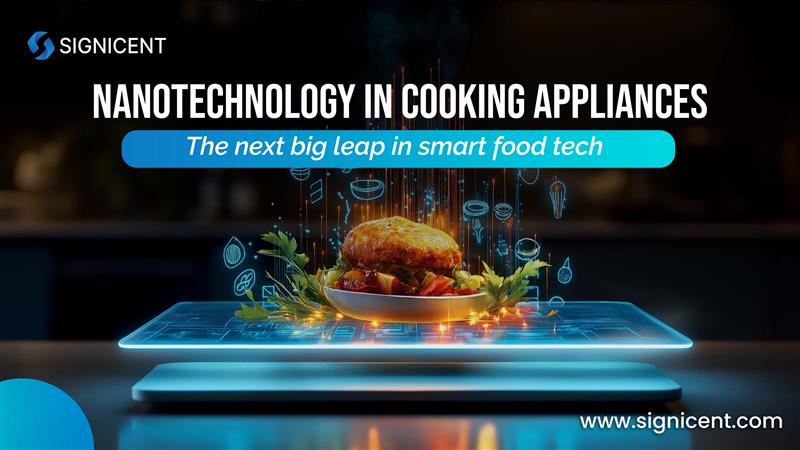Introduction: Nanotechnology is about to change how we cook
The kitchen is evolving fast, and nanotechnology in cooking appliances is becoming the driving force behind this shift. As smart kitchen technology grows more advanced, we’re entering a phase where meals cook quickly, appliances self-adjust with precision, and everyday tools are optimized for healthier living. From nano cooking technology that improves heat efficiency to smart kitchen appliances designed for faster cooking solutions, the future kitchen feels less manual and more intelligent.
At the same time, users want safer, cleaner options. Consequently, demand is rising for non-stick alternatives, PFAS-free cookware, and energy-efficient appliances that reduce waste without sacrificing performance. Traditional non-stick cookware is convenient but relies heavily on Teflon (PTFE) coatings containing PFAS, or “forever chemicals.” These chemicals persist in the environment and may pose health risks. Moreover, they do not degrade easily and can accumulate in the human body over time, raising serious concerns about toxicity, pollution, and food safety.
A recent breakthrough from the University of Toronto, a silicone-based PFAS-free nano-coating that performs like Teflon, shows how innovation is solving long-standing risks linked to traditional cookware. In short, nanotechnology is quietly driving the next generation of kitchen appliances. As a result, modern smart kitchens are becoming faster, safer, and designed for sustainable living with a clearer technology roadmap.
What are nanoscale appliances?
Nano-scale appliances operate at the nanometer scale (1–100 nm), manipulating materials and energy at the molecular or atomic level. Unlike traditional kitchen tools, these devices leverage nanotechnology in cooking appliances. smart kitchens, technology, advanced kitchen technology, nano cooking technology, nano heating technology, and AI algorithms to monitor and control temperature, flavor compounds, and cooking dynamics with extreme precision.
Core concepts in next-gen kitchen appliances
- Nano-particles for Heat Transfer: Materials engineered to conduct heat efficiently at microscopic levels, supporting energy-efficient kitchen appliances and future cooking technology.
- Embedded Nano-Sensors: Measure chemical composition, moisture, and nutrient content in real time, enabling modern smart kitchens and faster cooking solutions.
- AI-Driven Algorithms: Optimize cooking parameters based on the desired texture, taste, and nutritional profile, powering smart kitchen appliances and next-gen kitchen appliances.
These technologies allow appliances to cook, fetch, and assemble meals with near-perfect consistency, bridging science and culinary art while supporting PFAS-free cookware, safe non-stick alternatives, and kitchen technology for healthy cooking through current & future analysis powered by Signicent.

Understanding the science: How nano-heating works
At its core, nano-scale heating relies on surface engineering and quantum thermal control. This forms the backbone of nanotechnology in cooking, nano heating, and future kitchen technology. Materials like carbon nanotubes, graphene, and nano-ceramics have extraordinary electrical and thermal properties. As a result, they power new cooking technology and advanced appliances.
Core nano-heating functions in Smart Kitchen Technology
- Localized Heat Generation: Nanoparticles convert electrical energy into thermal energy within microseconds, heating only the required area, supporting energy-efficient kitchen appliances, energy saving kitchen appliances, and faster cooking solutions.
- Smart Temperature Feedback: Nano-sensors continuously monitor surface temperature to avoid overheating or nutrient loss, enabling modern smart kitchens, smart kitchen appliances, and kitchen technology for healthy cooking.
- Reduced Energy Waste: Because heat transfer happens at the atomic level, almost no energy escapes into the surroundings, a major advantage for future cooking technology, next-gen kitchen appliances, and nano cooking technology.
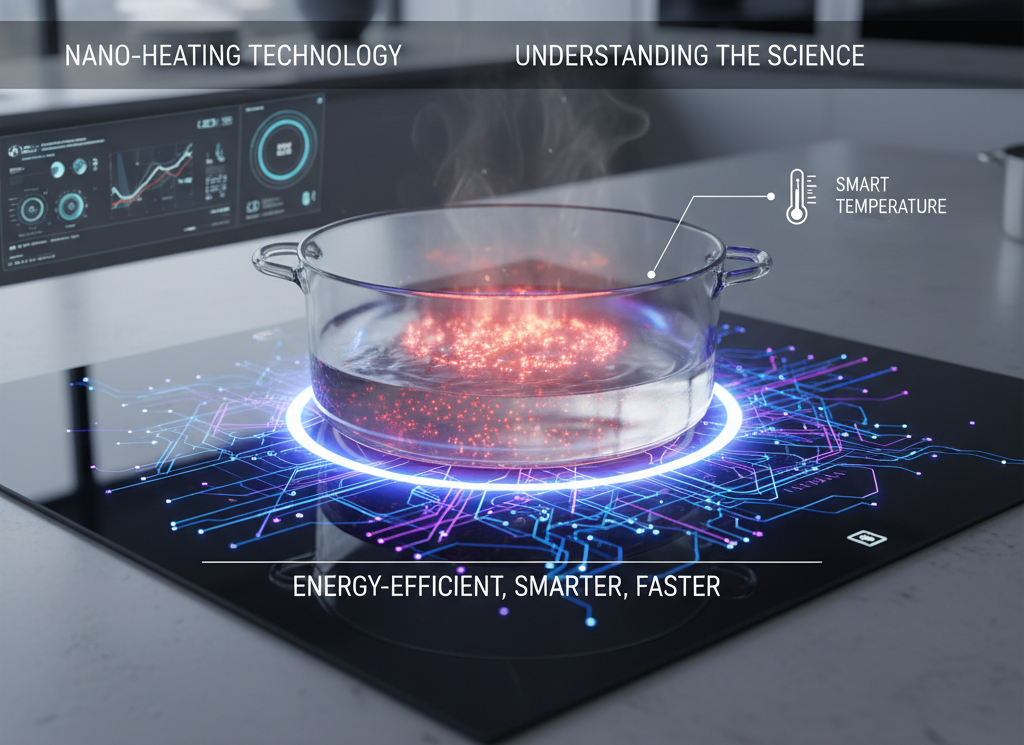
Why traditional cooking needs Reinvention
Conventional cooking methods, while effective, face growing limitations in today’s world of smart kitchen technology and future cooking technology:
Energy Inefficiency: Open flames or traditional resistive heating waste energy, making them less viable compared to energy-efficient kitchen appliances.
Time Constraints: Slow heating and manual adjustments extend cooking time, reducing the effectiveness of faster cooking solutions.
Nutritional Loss: Overcooking often degrades vitamins, minerals, and flavors, limiting progress toward kitchen technology for healthy cooking.
Inconsistency: Human error can lead to uneven cooking or under/over processing, unlike next-gen kitchen appliances with automated precision.
Food Waste: Lack of precision results in discarded ingredients or failed dishes.
Nano-scale appliances and nanotechnology in cooking address these challenges. By precisely controlling energy, timing, and ingredient processing at the molecular level, they reduce waste and enhance quality through advanced kitchen technology.
Nano-Scale Cooking vs Traditional Cooking
| Category | Nano-Scale Cooking | Traditional Cooking |
| 1. Heating Speed | Ultra-fast nano-level heating with almost no wait time. | Slow heating; relies on coils, gas, and long preheating. |
| 2. Precision & Control | Nano-sensors and AI adjust heat instantly and evenly. | Manual control; uneven heat and higher chances of burning. |
| 3. Energy Efficiency | Uses less power with graphene-based rapid heat transfer. | Wastes energy as ambient heat and needs longer cook times. |
| 4. Nutrition Retention | Faster, even cooking keeps nutrients and flavor intact. | Long exposure kills nutrients and weakens taste. |
| 5. Safety & Hygiene | PFAS-free nano-coatings + self-cleaning nano-surfaces. | Non-stick wears out; PFAS risks and inconsistent safety. |
| 6. Sustainability | Low power use, less waste, compact eco-friendly systems. | Higher energy use, more waste, bulky outdated tech. |
Why traditional Cooking Technologies fall short
Conventional appliances rely on bulk heat transfer, coils, resistors, or flame-based burners, which waste significant energy as ambient heat and lack the precision of nano cooking technology. Moreover, they:
• Require longer preheating times compared to nano heating technology.
• Offer poor temperature uniformity, especially in compact or portable designs, unlike modern smart kitchens with integrated nano-sensors.
• Consume excessive power in industrial and domestic use, reducing their value as energy saving kitchen appliances.
With cities moving toward net-zero living, such inefficiencies are no longer acceptable. Nano-enabled cooking systems, powered by nanotechnology in cooking, solve these issues through ultra-localized, sensor-driven heating, cutting energy use by up to 40% in lab prototypes while supporting the rise of advanced cooking appliances and future kitchen tech.
Key Innovations and Patent-Driven Breakthroughs
Nano-Coated Heating Films (Toshiba & LG Electronics)
Patents filed between 2022–2024 describe graphene oxide coatings applied to flexible substrates, enabling transparent and bendable cooktops that can be embedded in furniture or walls.
→ Supports next-gen kitchen appliances and advanced cooking appliances using nano cooking technology.
→ Helps build energy-efficient kitchen appliances with safer, PFAS-free non-stick alternatives.
Quantum Heat Sensors for Precision Cooking (Panasonic & Sony)
These devices integrate nano-thermistors that detect real-time chemical reactions in food, allowing automated temperature control to retain nutrients.
→ Enhances smart kitchen appliances with AI-driven precision for kitchen technology for healthy cooking.
→ Strengthens future cooking technology through molecular-level feedback systems.
Self-Sterilizing Nano Surfaces (Samsung Labs)
Utilizing titanium-dioxide (TiO₂) nanolayers activated by UV light, surfaces become antimicrobial and self-cleaning, reducing chemical detergent use in commercial kitchens.
→ Improves modern smart kitchens with nano-enabled hygiene systems.
→ Aligns with energy saving kitchen appliances and sustainable smart kitchen technology trends.
Each of these breakthroughs shows how nanotechnology in cooking appliances merges sustainability with automation. As a result, energy waste is minimized, safety and hygiene improve, and open innovation advances, laying the foundation for future kitchen technology powered by nano heating and nanotechnology.
Nano-Tech breakthroughs that are redefining Smart Cooking Systems
Nanotechnology in cooking appliances is powering a new wave of smart kitchen technology by merging nanomaterials, sensors, and AI for faster, cleaner, and more energy-efficient cooking. These systems boost nano cooking technology, support advanced kitchen technology, and enable next-gen kitchen appliances designed for precision and sustainability.
Core Innovations
- Nano-heat conduction systems using graphene/CNTs for ultrafast, even heating and energy-efficient kitchen appliances.
- Smart nano-sensors that read flavor chemistry and moisture, enabling AI-driven cooking for healthier results.
- Molecular-level 3D food printing for personalized meals with exact textures and nutrients.
These breakthroughs turn modern smart kitchens into intelligent, automated food labs.
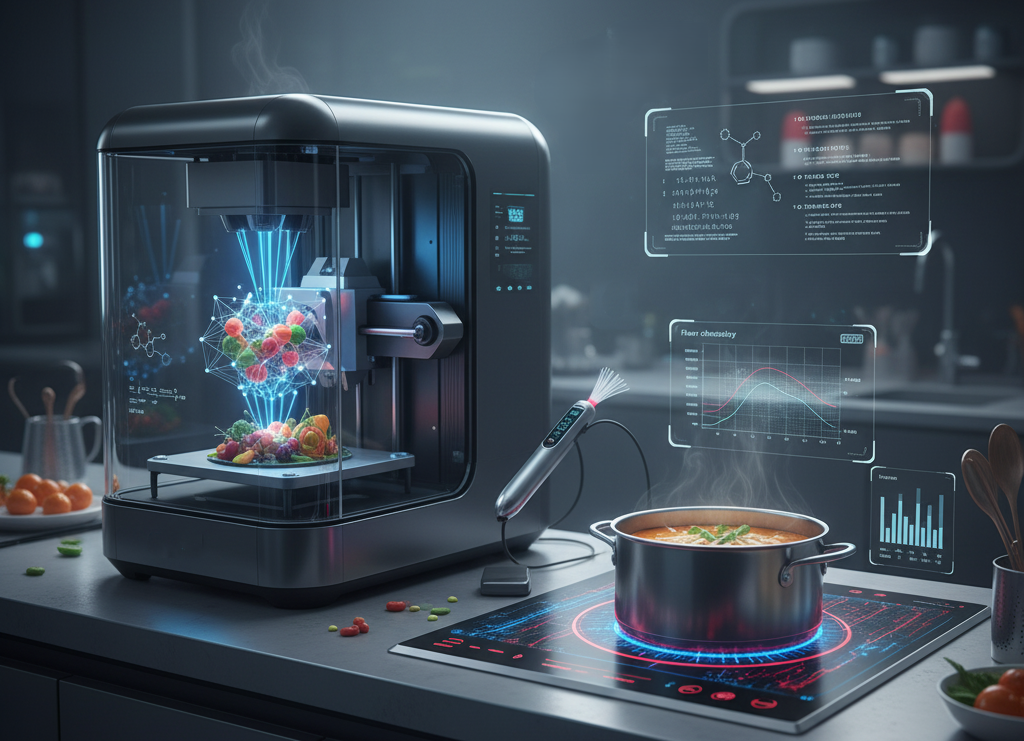
Benefits Driving the Future of Green Cooking & Sustainability Impact
From automated cooking arms to molecular-level ingredient manipulation, the new wave of nano-cooking devices promises faster cooking, higher nutritional retention, and minimized waste, while environmental and economic angles show the benefits hit strong:
- Energy Efficiency:
Precise thermal targeting minimizes heat loss, cutting overall power consumption and making nano-enabled systems far more efficient than traditional cooking tech.
- Material Longevity:
Advanced nano-coatings resist corrosion, scratching, and thermal fatigue. As a result, cookware lasts longer with consistent performance, thereby reducing the need for frequent replacements.
- Waste Reduction:
Real-time nano-sensors monitor ingredient changes and prevent overcooking, helping save food, reduce kitchen waste, and support waste-free cooking practices.
- Smaller Carbon Footprint:
Compact nano-powered cooking units work seamlessly with portable solar setups, enabling clean, low-emission cooking even in remote or off-grid regions.
These advancements strongly align with the UN’s sustainability goals, especially affordable clean energy (SDG 7) and responsible consumption (SDG 12), while supporting ongoing Regulatory Monitoring to ensure compliance, making modern kitchens smarter, greener, and more future-ready.
Market Outlook for Smart Kitchen Cooking Appliances
The next generation of cooking appliances, powered by nanotechnology, AI, and smart automation, is experiencing rapid global growth as consumers shift toward faster, healthier, and more energy-efficient cooking solutions
According to Signicent Market Research, the global smart and nano-enabled cooking appliance market is set to expand sharply, driven by breakthroughs in nano-sensors, efficient heat-conduction systems, and AI-based automation.
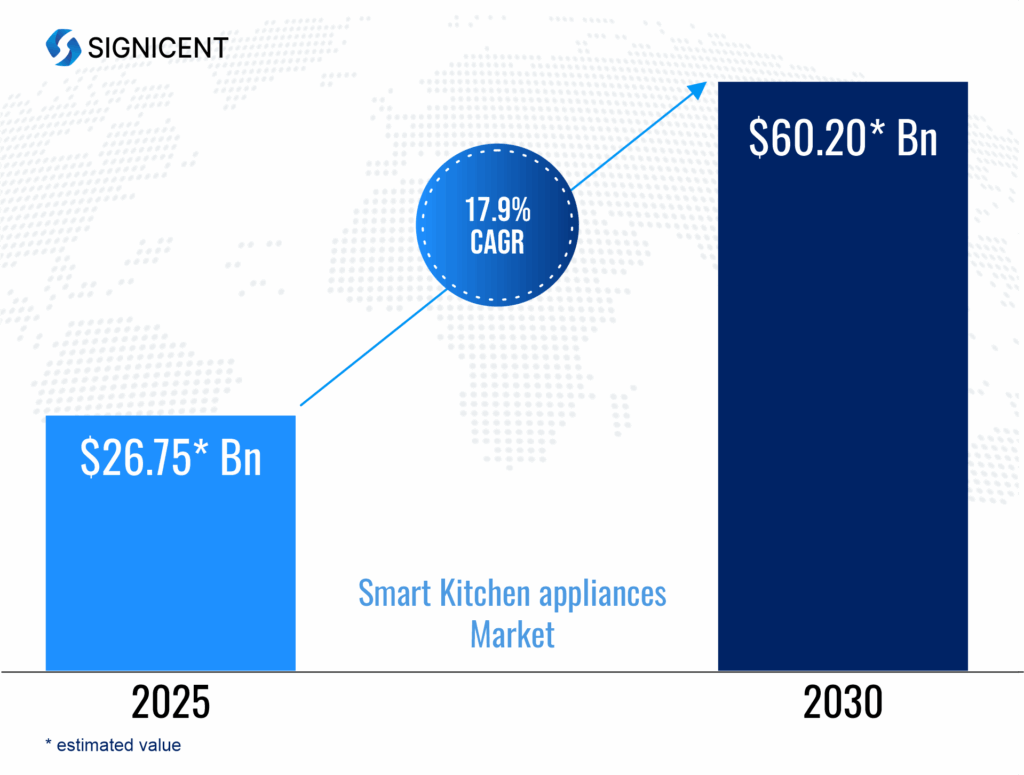
The demand for PFAS-free cookware, precision cooking, and energy-saving appliances is growing. Consequently, the market expands as industries and consumers shift away from outdated, high-energy cooking systems.
Below are some key consequences of this shift:
- Rising urbanization and smart home adoption
- Demand for personalized, healthy meals
- Integration of AI, IoT, and nano-sensors in appliances
- Sustainability initiatives to reduce energy consumption and food waste across households, restaurants, and food-tech labs.
Top 7 Global Leaders Driving Nano-Technology Cooking Appliances
These global giants are shaping the future of smart, nano-enabled cooking appliances through advanced materials, AI-powered systems, and energy-efficient technologies built for next-gen kitchens.
1️⃣ LG Electronics
2️⃣ Samsung
3️⃣ Panasonic
4️⃣ Electrolux
5️⃣ Haier
6️⃣ Bosch
7️⃣ Whirlpool
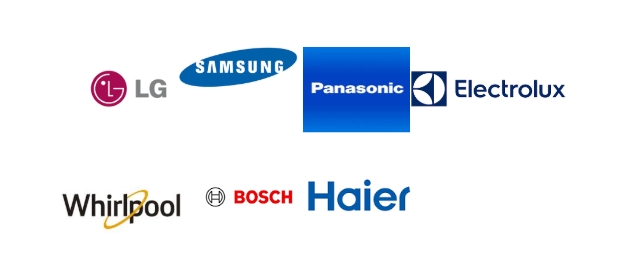
How Signicent Helps Clients in Nano-Cooking Technology Innovation
Signicent helps organisations develop nano-cooking solutions that are ready for the future by combining deep technical knowledge, innovation scouting, and advanced analytics to speed up breakthroughs, lower risks, and speed up market success.
Patent Analysis
Identifying nano-heating breakthroughs, PFAS-free nano-coatings, AI-powered cooktops, and securing core IP in advanced kitchen technology.
Market Research & Forecasting
Mapping demand for smart kitchen appliances, nano cooking technology, and energy-efficient kitchen appliances across global markets.
Technology Scouting
Connecting clients with startups, labs, and institutions developing nano-sensors, graphene heating elements, and next-gen kitchen appliances.
Competitive Benchmarking
Comparing product performance, efficiency, innovation maturity, and nano-tech adoption across global leaders.
IP & Innovation Strategy Support
Helping companies accelerate R&D, reduce tech risks, and enter new markets with data-backed insights.
Live Reports & Advanced Analytics
Providing real-time, interactive reports powered by advanced data analytics, enabling teams to execute decisions anytime, anywhere, with location-based precision.
Conclusion – shaping the future of Nano-Enabled Smart Kitchens
Nano-cooking technology represents not merely an improvement but a completely new domain for precision, sustainability, and advanced culinary innovation. With the integration of nano-heating, AI-driven sensors, and atom-level energy systems into common appliances, kitchens are transforming into small, intelligent, and eco-efficient culinary laboratories that align with contemporary lifestyles.
In a world where consumers want speed and quality, nano-appliances deliver faster heating, cleaner energy use, and superior nutrient retention. They also produce almost zero waste. From molecular-level ingredient control to compact cookers that learn from food chemistry, this wave is set to dominate homes and professional kitchens alike.
For companies exploring this space, the opportunity is massive, and Signicent helps you capture it with deep tech intelligence, white-space insights, and innovation scouting tailored to your product roadmap. With our support, you can turn breakthrough ideas into market-ready nano-cooking solutions that meet global sustainability goals and win the next generation of smart-kitchen customers.
Frequently Asked Questions (FAQ’s) about Nano-Cooking Tech
1. What is nanotechnology in cooking appliances?
Nanotechnology in cooking appliances uses nanomaterials, nano-sensors, and advanced coatings to boost heating efficiency, precision, and sustainability. It enables real-time temperature control and atom-level heat distribution.
2. How do nano-enabled kitchen appliances save energy?
They use high-conductivity materials like graphene and nano-ceramics, which heat quickly and retain heat longer. Smart nano-sensors prevent power wastage by regulating heat automatically.
3. Are nano-cooking devices safe for domestic use?
Yes. They use food-safe, PFAS-free coatings and undergo non-toxicity, thermal stability, and chemical-resistance tests. These appliances follow international safety guidelines and are safe for daily use.
4. What are the benefits of nano-coatings in cookware?
Nano-coatings ensure even heating, a non-stick surface, durability, scratch resistance, and PFAS-free performance. They help preserve texture, nutrition, and flavor during cooking.
5. Which industries use nano-cooking technology?
Industries include household kitchens, smart home ecosystems, commercial kitchens, restaurants, food-tech labs, and convenience-food production units.
6. How does nanotechnology improve cooking precision?
Nano-sensors detect food composition changes and adjust heat instantly. This avoids burning, prevents nutrient loss, and guarantees perfect doneness.
7. How does Signicent help in nano-cooking innovation?
Signicent provides patent analysis, technology scouting, competitive benchmarking, white-space mapping, and market forecasting — helping brands accelerate innovation with real-time insights.
About Signicent LLP
Signicent supports businesses worldwide with their innovation journeys – from R&D and new product development to patents, valuation, commercialization, and deep tech-market intelligence.
Our Core Services
- Patent Landscape
- Patent Portfolio Analysis
- Patent Invalidity Search
- Patent Licensing Services
- Freedom to operate (FTO)
- Chemical Structure Search
- Design Patent Search
- Technology Scouting
- Technology Landscape Analysis
- Technology gap analysis
- Technology Intelligence
- Market Research
- Bio Sequence Search
Why Signicent?
We help you elevate your innovation with a research-driven, tech-forward approach that aligns technology insights, market trends, and IP strategy— all in one place.


